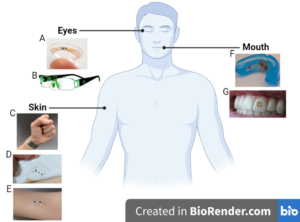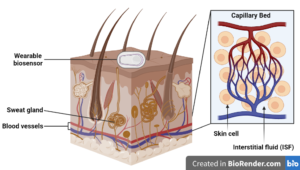Digital health is a fast-growing area of healthcare that uses technological innovation to enhance the global healthcare experience. Not only can digital health developments improve healthcare systems and telemedicine, but the intersection between health and technology has the potential to revolutionize personalized medicine. Wearable sensors are a rapidly expanding area of digital health, with a global market value estimated to reach $2.86 billion by 2025. Wearable sensors are devices that detect and relay important bodily information, such as the common smartwatch that tracks physical activity, heart rate, and sleep cycles. The convenience of wearable sensors allows people to digitally monitor their health on a daily basis.

A significant portion of the future market in wearable sensors includes biosensors, which are sensing devices that detect specific biological elements and translate that recognition event into a measurable signal. For example, a biosensor may recognize an increase in blood sugar levels, translate that signal, and display the amount on the screen of a monitoring device. Wearable biosensors are flexible and stable devices that provide continuous and real-time health monitoring. Several fluids, like sweat, tears, and saliva can be studied without penetrating the body; this allows for noninvasive measurement of biological substances linked to health and disease (Figure 1). Skin-based wearable biosensors currently show the most promise for future commercialization, as they allow for easy measurement of many important signals without piercing the outermost layer of skin.
The skin is the body’s largest organ and provides simple access to valuable information through interstitial fluid (ISF) and sweat. ISF is the fluid that surrounds skin cells and contains nutrients that seep out from the blood capillaries just below the surface of the skin. ISF can be used to estimate the levels of substances within the blood, but it must be drawn to the skin surface before being examined. There are ways to draw out ISF and use it for biosensor technology, but these methods are prone to causing skin irritation. Sweat is a more easily attainable fluid for skin sensing, as there are more than 100 glands/cm2 of skin across the entire body that can collectively produce liters of sweat per day. Both ISF and sweat can help us monitor changes in blood sugar, alcohol, hormones, electrolytes, and immune signals. Skin sampling methods under development include “E-skin” (wearable electronic skin), digitized temporary tattoos, wristbands, and patches (Figure 1 and 2).

The benefit of wearable biosensors, notably sweat-based platforms, is exemplified by the advancements in blood glucose (sugar) monitoring. Diabetes is a steadily growing global health problem that affects over 422 million people, resulting in improper maintenance of blood sugar and severe health complications. For people with diabetes, current blood sugar tracking methods are often invasive, painful, and inefficient. Now, over 60 years after the first-generation glucose biosensor, wearable biosensors are being developed to improve diabetes management. At-home wearable biosensors would allow for continuous monitoring of blood sugar levels and improve disease maintenance, highlighting the potential for these devices to improve health outcomes in the digital world.
Now more than ever, people are using technology to track their daily personal health. Wearable biosensors are a growing area of digital health that can provide essential health information while minimizing the risk of harm. In addition, these user-friendly sampling platforms could eventually allow for the simultaneous and constant monitoring of multiple body sites and signals. For example, wearable biosensors are being developed to monitor stress hormones, blood alcohol levels, and cardiovascular health. While it will take more research before wearable biosensors become widely available, they certainly hold the power to modernize healthcare and transform personal health experiences.
Peer edited by: Jillian Battista